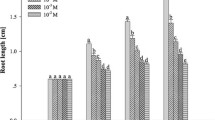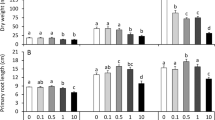Abstract
The effect of 2–48 h treatment of Lupinus angustifolius L. roots with lead nitrate at the concentration of 10−4 M on the nucleoli in meristematic cells was investigated. In the lead presence the number of ring-shaped as well as segregated nucleoli increased especially after 12–48 h of treatment, while spindle-shaped nucleoli appeared after 24 h and 48 h. Lead presence also increased the frequency of cells with silver-stained particles in the nucleus and the number of these particles especially from the 12th hour of treatment. It was accompanied by significant decline of nucleolar area. Analysis of these cells in transmission electron microscope confirmed the presence of ring-shaped and segregated nucleoli. Moreover, electron microscopy revealed compact structure nucleoli without granular component. Additionally, one to three oval-shaped fibrillar structures attached to nucleolus or lying free in the nucleoplasm were visible. The possible mechanism of lead toxicity to the nucleolus is briefly discussed.








Similar content being viewed by others
References
Carruyo I, Fernández Y, Marcano L, Montiel X, Torrealba Z (2008) Correlation of toxicity with lead content in root tip cells (Allium cepa L.). Biol Trace Elem Res 125:276–285
Collins AR (2004) The comet assay for DNA damage and repair: principles, applications, and limitations. Mol Biotechnol 26:249–261
Derenzini M, Farabegoli F, Trere D (1993) Localization of DNA in the fibrillar components of the nucleolus: a cytochemical and morphometric study. J Histochem Cytochem 41:829–836
Doncheva S (1997) Ultrastructural localization of Ag-NOR proteins in root meristem cells after copper treatment. J Plant Physiol 151:243–245
Epstein AL, Gussman CD, Blaylock MJ, Yermiyahu U, Huang JW, Kapulnik Y, Orser CS (1999) EDTA and Pb-EDTA accumulation in Brassica juncea grown in Pb-amended soil. Plant Soil 208:87–94
Gabara B, Krajewska M, Stecka E (1995) Calcium effect on number, dimension and activity of nucleoli in cortex cells of pea (Pisum sativum L.) roots after treatment with heavy metals. Plant Sci 111:153–161
Glater RA, Hernandez L (1972) Lead detection in lining plant tissue using a new histochemical method. J Air Pollut Control Assoc 22:463–467
Glińska S, Bartczak M, Oleksiak S, Wolska A, Gabara B, Posmyk M, Janas K (2007) Effects of anthocyanin-rich extract from red cabbage leaves on meristematic cells of Allium cepa L. roots treated with heavy metals. Ecotoxicol Environ Saf 68:343–350
Howell W, Black DA (1980) Controlled silver-staining of nucleolus organizing regions with a protective colloidal developer: a 1-step method. Experientia 36:1014
Jiang W, Liu D (1999) Effects of Pb2+ on root growth, cell division, and nucleolus of Brassica juncea L. Isr J Plant Sci 47:153–156
Jiang W, Liu D (2000) Effects of Pb2+ on root growth, cell division, and nucleolus of Zea mays L. Bull Environ Contam Toxicol 65:786–793
Jiang W, Liu D, Hou W (2000a) Hyperaccumulation of lead by roots, hypocotyls and shoots of Brassica juncea. Biol Plant 43:603–606
Jiang W, Liu D, Li H (2000b) Effects of Cu2+ on root growth, cell division, and nucleolus of Helianthus annuus L. Sci Total Environ 256:59–65
Kabata-Pendias A, Pendias H (1999) Biogeochemistry of trace elements. PWN, Warsaw
Kim SH (2009) Plant nucleolar dynamics. J Plant Biol 52:193–201
Kuran H, Kononowicz AK (1979) Effect of starvation on the genetic activity on nucleus and nucleolar organizer. Folia Histochem Cytochem 17:59–68
Liu D, Jiang W (1995) Effects of Ca2+ ions antagonistic to Al3+ ions poisoning in root growth, cell division and nucleolus in root tip cells of Allium cepa. J Environ Sci 7:190–197
Liu D, Jiang W, Wang W, Zhao F, Lu C (1994a) Effects of lead on root growth, cell division and nucleolus of Allium cepa. Environ Poll 86:1–4
Liu D, Jiang W, Guo L, Yuqing H, Cheng L, Fengmei Z (1994b) Effects of nickel sulfate on root growth and nucleoli in root tip cells of Allium cepa. Isr J Plant Sci 42:143–48
Liu D, Jiang W, Gao X (2003) Effects of cadmium on root growth, cell division and nucleoli in root tip cells of garlic. Biol Plant 47:79–83
Marcano L, Carruyo I, Del Campo A, Montiel X (2002) Effect of cadmium on the nucleoli of meristematic cells of onion Allium cepa L: an ultrastructural study. Environ Res Sec A 88:30–35
Przymusiński R, Banaszak A, Gwóźdź EA (2001) Organospecific responses of lupin seedlings to lead I. Localization of lead ions and stress proteins. Acta Physiol Plant 23:109–116
Przymusiński R, Rucińska R, Gwóźdź EA (2004) Increased accumulation of pathogenesis-related proteins in response of lupine roots to various abiotic stresses. Environ Exp Bot 52:53–61
Przymusiński R, Rucińska-Sobkowiak R, Ilska B, Gwóźdź EA (2007) Organospecific responses of lupin seedlings to lead. Localization of hydrogen peroxide and peroxidase activity. Acta Physiol Plant 29:411–416
Reynolds S (1963) The use of lead citrate of high pH as an electron-opaque stain in electron microscope. J Cell Biol 17:208–212
Risueño MC, Medina FJ (1986) The nucleolar structure in plant cells. Cell Biol Rev 7:1–140
Samardakiewicz S, Woźny A (2005) Cell division in Lemna minor roots treated with lead. Aquat Bot 83:289–295
Sato S, Sato M (1984) Peculiar behavior of the nucleolus and apperance of cytoplasmic nucleolus-like bodies in the roottip meristems of Brodiaea uniflora Engl. grown at low temperature. Protoplasma 120:197–208
Sengar RS, Gautam M, Sengar RS, Garg SK, Sengar K, Chaudhary R (2008) Lead stress effects on physiobiochemical activities of higher plants. Rev Environ Contam Toxicol 196:73–93
Shang G, Wang F, Hao S, Jiao M (2009) Dynamic changes of nucleolar DNA configuration and distribution during the cell cycle in Allium sativum cells. Micron 40:449–454
Stępiński D (2008) Nucleolar vacuolation in soybean root meristematic cells during recovery after chilling. Biol Plant 52:507–512
Stępiński D (2010) Organization of the nucleoli of soybean root meristematic cells after different states of their activity. Micron 41:283–288
Thiry M, Lafontaine DLJ (2005) Birth of a nucleolus: the evolution of nucleolar compartments. Trends Cell Biol 15:194–199
Tice RR, Agurell E, Anderson D, Burlinson B, Hartmann A, Kobayashi H, Miyamae Y, Rojas E, Ryu J-C, Sasaki YF (2000) Single cell gel/comet assay: guidelines for in vitro and in vivo genetic toxicology testing. Environ Mol Mutagen 35:206–221
Wang F, Shang G, Hao S, Jiao M (2006) Dynamic change and derivation process of FC and DFC through G1, S and G2 phases in HeLa cells. Cell Biol Internat 30:836–840
Wierzbicka M (1999) The effect of lead on the cell cycle in root meristem of Allium cepa L. Protoplasma 207:186–194
Wierzbicka M, Obidzińska J (1998) The effect of lead on seed imbibition and germination in different plant species. Plant Sci 137:155–171
Wilkins DA (1957) A technique for the measurement of lead tolerance in plants. Nature 180:37–38
Conflict of interest
The authors declare that they have no conflict of interest.
Author information
Authors and Affiliations
Corresponding author
Additional information
Handling Editor: Bhumi Nath Tripathi
Rights and permissions
About this article
Cite this article
Balcerzak, Ł., Glińska, S. & Godlewski, M. The reaction of Lupinus angustifolius L. root meristematic cell nucleoli to lead. Protoplasma 248, 353–361 (2011). https://doi.org/10.1007/s00709-010-0177-x
Received:
Accepted:
Published:
Issue Date:
DOI: https://doi.org/10.1007/s00709-010-0177-x




